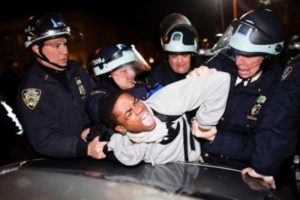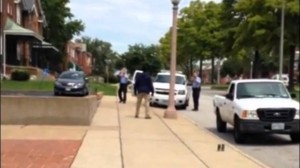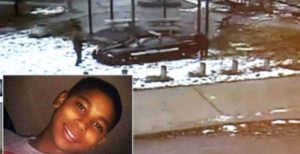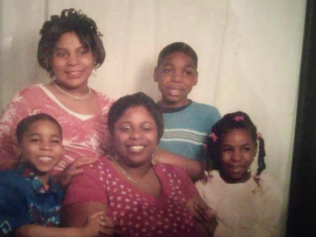It was frustration with the racism he felt from the police officers who frequently pulled him over in his late-model vehicle that compelled Glenn Rogers to become a police officer in the St. Louis area 25 years ago. And it is still racism in the police force that is pushing Rogers to speak out now in anger and frustration, seven years after his retirement.
Rogers, 64, is a former police officer and undercover detective for several municipalities in St. Louis County and was a police chief for a short time in southwestern Illinois and a police chaplain in three different departments. He has watched the events transpiring in Ferguson with the unique perspective of someone who understands what it’s like on both sides of the badge. And after more than two decades in law enforcement, Rogers knows that the racism of many white police officers that has exploded into the public consciousness in recent months is a real, palpable, unwieldy thing.
From the first days after he joined the police force of a town in St. Louis County in 1990—a place that, like Ferguson, had an overwhelmingly white police department in a majority Black town—Rogers was stunned by the obvious contempt his white colleagues had for the Black citizens they were paid to serve and protect.
“As I began to see how Black people got talked to, treated, grabbed, arrested, how they got dealt with when being incarcerated, to me it looked like something off a slave boat when you actually saw the booking process and the handcuffing process,” Rogers, 64, told Atlanta Blackstar in an exclusive interview. “It was just a long lineup of Black people. I don’t think in the first year I saw more than one or two white people arrested. And those were usually for failure to appear for tickets.”
The Heartlessness of White Officers
Over the next few years, Rogers said he could not believe how much heartlessness and hostility white officers brought into encounters with Black people. Rogers calls this the “human element”—the part of the job where officers get to use their discretion in deciding how to respond to any given situation.
These are the situations where Black people often met danger.
“The human element has got to be put in check,” said Rogers, who has served as a police advisor to six different mayors in the St. Louis area. “There is an area of discretion involved in every job and the same with law enforcement. The human element has to decipher and make a decision when it’s not clearcut by law or by what is apparent before you. When they say cops have split seconds to make decisions, it is not a lie. The main goal of a police officer—as I told the new officers I trained—is to go home at night. You did not put the uniform on to end up in a body bag unnecessarily from just being stupid and foolish. You can’t trust anybody on the street because you don’t know what they’re going to do. But with that, you also have an obligation to be humane, to only use what is necessary to accomplish your job and go home at night. I found that many times white officers do things knowing that Black people don’t stick together, knowing you can always do something to a Black person and 95 percent of the time you will come out unscathed and it will go away and you can continue as usual.”

“That is a primary tool that they use, talking to you in a way that creates strife and envy and hatred, versus talking to you in a way that reduces tension,” he said. “Grabbing you or accidentally doing something to you or embarrassing you in a way we’re not accustomed to. Instead of just shutting up, you want to say something back—and that’s all they need to start a spark and then they inflate it. Cops know how to make you respond in a way for them to do in their mind what they want to do, whether it’s peaceful or it’s violent. They know and they do it everyday.”
Rogers said he saw a Youtube video that perfectly illustrated what he means by the “human element.” The video features a white woman—clearly with mental issues—getting out of a pickup truck, swinging a knife at a bunch of white officers, almost slashing one in the leg. The officers respond by wrestling her to the ground—in a situation where the use of deadly force would have been appropriate.
He contrasted that with the cellphone video footage of the St. Louis officers gunning down 25-year-old Kajieme Powell, less than four miles from the spot where police officer Darren Wilson killed 18-year-old Michael Brown two weeks earlier. Though Powell was obviously mentally unstable, wandering around the sidewalk mumbling to himself and then yelling, “Shoot me, kill me now” at the police officers, his hands were at his sides when the police opened fire and he was still not very close to them.
“In a situation like that, do you know you can appeal to a person?” Rogers said. “In a situation like that, had there been only Black officers responding, the Black officers would have said, ‘Hey man, put that knife down before you get hurt. You’re gonna mess around and get yourself shot and killed. I’m not playing with you, put it down.’ That’s the kind of thing they would have said. The white officers, not having in their heart compassion to give him a second chance, but knowing, ‘Ah, this man has crossed the line and deadly force would be authorized,’ they just come right out and shoot him and kill him. Boom. There was no attempt to see what verbal negotiation or verbal skill would accomplish.”
Rogers provoked the ire of his fellow officers from the very beginning of his career because they saw that he would not sit quietly when he saw injustices being committed. But he said the “chain of command” stifles the voice of honest officers, makes them shut up in order to keep their jobs and avoid harassment.
“There are many good cops, but they do not speak up,” he said. “When people try to imply that all cops are bad, all the white ones are bad, all the Black ones are bad, that’s not true. I found there’s a group of about 15 percent that are rotten to the core, or so self-serving they may do anything. These ones go for power and authority ruthlessly and are as slick as possible. They would eliminate anything and anybody in the process on their way to the top. And unfortunately, I found the ones who are basically good cops by nature don’t ruthlessly go for promotion.”
Why We Don’t Hear About White-on-White Crime
Rogers said he went into the job believing what he saw on the news at night—that most of the crime was committed by young Black males. But through friends who were officers in St. Louis, he began to see stacks of arrest sheets that told a different story: There were scores of white people being arrested for serious crimes like rape, burglary and assault, but they would never show up on the evening news.
“Some of the officers I knew in St. Louis made me very much aware of white-on-white crime that never hits the news,” he said. “They made me aware of this for over a year, in the officers association we had. I’d read the sheets with the crime reports. I was shocked. Living here, I didn’t think white-on-white crime was like that, was that prevalent. But here I am, reading page after page of white people committing crimes against each other. But what I was seeing on the news was always a Black person against a Black person, or a Black person against a white person. Or just a white person drunk somewhere or who periodically stole some money from a company. But these incident reports showed white people committing assault, rape, burglary, you name it. I couldn’t believe it. Even as an officer I’m thinking this is impossible. There has to be a concerted and intentional control and determination by the media to paint white people as innocent and not crime-ridden. These sheets had names, addresses, everything. None of it was on the news. This was not over a period of one or two weeks, but to this very day.”
Black People Need to Learn the Law
Rogers said the white officers knew Black people weren’t likely to know how the system worked, or to understand their rights, so it was easy to make them run afoul of the law.
“They saw Black people in my opinion as the people you could practice on and get your skills straight,” he said. “They were the people who didn’t know how to deal with the system, so therefore they would make all the mistakes that needed to be made for officers to do to them the things they do to people who make those mistakes. This is why I saw it is intentional that the public is never taught the real mechanics of the law. If you do so, you will eliminate hundreds of thousands if not millions of incidents where they encounter the police or are candidates for arrest.
“If this country means to do right by its people they absolutely must begin to teach the law and how to avoid violating the law. And little particular nuances of the law so the people would know how to not get arrested. But that would be against the system as I see it today. I would say ignorance of the law is the reason that at least half the people who get arrested get arrested. For example, a person didn’t know that if a police officer is talking to someone and they come over there and get in the conversation, they can be charged with obstruction of justice or interfering with a police officer. A police officer only has to turn around and say, ‘You’re arrested for obstructing, interfering.’ They didn’t even know it could happen. Hundreds and hundreds of times I’ve seen those sort of things.”
 Deadly Force: The Case of Michael Brown
Deadly Force: The Case of Michael Brown
When it comes to the issue of police use of deadly force, which has become the center of a national debate, Rogers said officers are taught to use deadly force to stop a person, not to kill them.
“The rule is two shots to the torso and one to the head,” he explained. “Because sometimes people wear body armor, bad guys can wear them too, so that’s the series of shots we use, shooting in critical mass areas so they can stop a person who is posing an immediate threat to the officer or the public or to property. That is designed to stop and not to kill, even though when you shoot them in critical areas that normally will cause death. But sometimes they don’t die. When you have the public asking questions like, ‘Why didn’t he shoot him in the leg?’ the truth of the matter is, a lot of police officers can’t hit a bucket from 40 or 30 feet away. That’s a fact. Cops who see this will know it’s a fact. If there’s a shot that needs to be fired for use of deadly force, they need to shoot critical mass areas because they’re not good enough to be doing what people think, having some Annie Oakley type of special shooting skill. Some of them can’t even shoot as good as the public.”
He said he is disturbed that the justice system has now gotten to the point where all a cop has to do is say he was in danger and everybody just accepts it as fact.
“Things have gotten more favorable towards the police,” he said. “The humane way of looking at use of force was this: they taught us the use of force is given to police officers to go one level above the threat. If you’re coming to me barehanded and want to fight me with no weapon in your hand, I would be justified in using my mace or a baton or a Taser. No problem. If you had a knife in your hand in the same scenario, I can use mace or a Taser or even use deadly force because you have a deadly weapon. But if by the same scenario you’re in a fistfight with someone and come rushing over to me and I shoot and kill you and you had nothing in your hands, then I should be charged with an abuse of power. Because I didn’t use appropriate levels to subdue the situation. I just shot and killed you. But now they’ve got the law so that if an officer says he felt threatened or if he felt fear, he could shoot to kill.
“Like with Michael Brown and Darren Wilson. They kept talking about the size of Michael Brown. But Darren Wilson was only a few inches different. Look at the interview he did on TV; he dwarfed the interviewer. But this was something to justify the shooting. To say, ‘I felt threatened.’ That’s where the human element comes in. Unfortunately the law now is backing the human element. But here’s the problem. For a white officer, any officer, to tell you they felt fear, that is so discretionary. That’s something that can’t be legislated. It just has to be verbally accepted. You say you felt afraid because they charged you, like Darren Wilson said, he charged with his head down, which I don’t believe at all. But a white person is prone to feel fear when a Black person is standing next to them in an elevator. Or in the store or the mall or anywhere. That element is there. So are they then justified to shoot and kill? That’s gotta be changed.”
 Black Lives Don’t Matter: The Case of Tamir Rice
Black Lives Don’t Matter: The Case of Tamir Rice
The Black Lives Matter protests are centered around the idea that too often these officers don’t value Black life as much as white life—which Rogers said he saw proven all the time on the job.
“This is why you never hardly see a rich white person’s family members shot and killed by the police,” he said. “They know damn well when they get there, if they find a young white kid in his 20’s, swinging a knife or even flourishing a gun, if he’s in a nice brand-new car, looks like a clean cut kid, they assume subliminally this is not what you call ‘white trash’ here, so they take the time to protect themselves. You mess around and shoot an influential dad’s son, your career may be over, buddy.”
But then there are cases like Tamir Rice, where the officers came up on a 12-year-old boy in the park, playing with a toy gun, and shot him within a matter of seconds.
“There is no reason in the world they couldn’t make an attempt to talk to him with the bullhorn,” Rogers said, his voice rising in anger. “When I saw that video with Tamir Rice, that really saddened me. I almost got tearful late one night looking at the whole thing, thinking, Man, my people are treated like dogs. They shot this little kid down. I got a son that age. The little kid was just playing with snowballs. This is what I say about teaching the public. If someone had called his mom or father and told them that there is a huge chance that the police can misconstrue the toy—or not even misconstrue it but know it’s a toy and shoot and kill you and say they didn’t know. With this kid they didn’t even try. The point is, they didn’t even try.”






